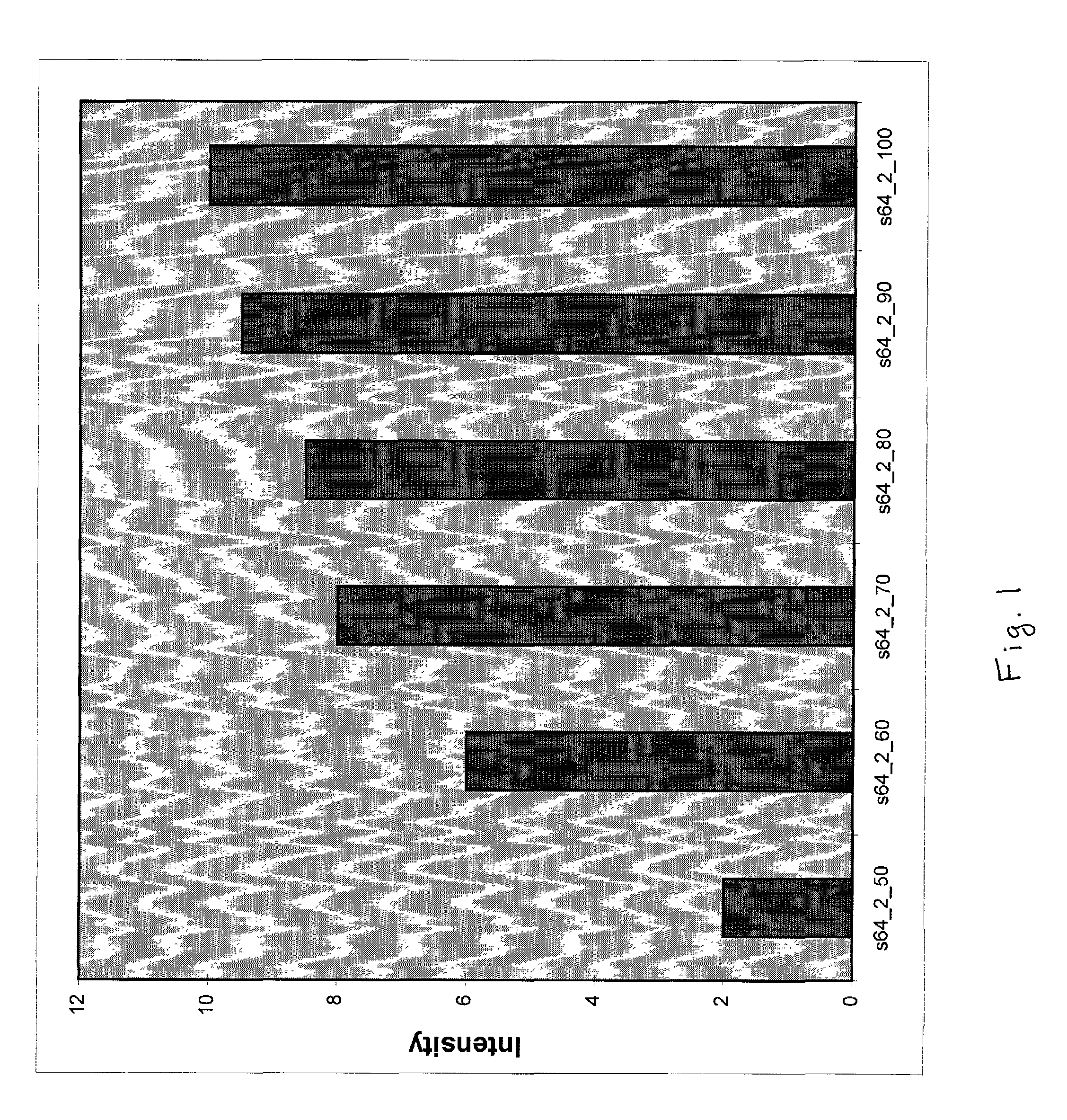Long oligonucleotide arrays
a technology of oligonucleotide arrays and oligonucleotide libraries, applied in the field of nucleic acid arrays, can solve the problems of low reproducibility of such arrays, disadvantages, and difficulty in large-scale production of such arrays, and achieve the same hybridization efficiency, low non-specific binding, and high target binding efficiency
- Summary
- Abstract
- Description
- Claims
- Application Information
AI Technical Summary
Benefits of technology
Problems solved by technology
Method used
Image
Examples
example 1
Generation of 32P-labeled hybridization target
Step A. cDNA Synthesis / Labeling Procedure
[0100]The 10-μl reaction described below convert 1 μg of synthetic control RNA into 32P-labeled first-strand cDNA.
[0101]For each labeling reaction:[0102]1. Prepare enough master mix for all labeling reactions and 1 extra reaction to ensure sufficient volume. For each 10-μl labeling reaction, mix the following reagents:
[0103]2μl5×First-strandbuffer(250μMTris-HClpH8.3;375mMKCl;15mMMgCl2)1μl10×dNTPmix(500μMdGTP,500μMdCTP,500μMdTTP,5μMdATP)4μl[α-33P]dATP(Amersham,2500Ci / mmol,10mCi / ml)1μlMMLVreversetranscriptase(Amersham,200units / μl)8μlFinalvolume[0104]2. Combine the following in a 0.5-ml PCR test tube:[0105]1 μg (1 μl) control s64 RNA
[0106]
GGCCA GGATACCAAA GCCTTACAGG ACTTCCTCCT CAGTGTGCAG ATGTGCCCAG GTAATCGAGA(SEQ ID NO:01)CACTTACTTT CACCTGCTTC AGACTCTGAA GAGGCTAGAT CGGAGGGATG AGGCCACTGCACTCTGGTGG A...
example 2
Preparation of Amynopropyl-glass
[0132]1. Prepare wash solution: to get 2 liters, dissolve 200 g NaOH in 600 ml water and make up volume to 1 liter (20% w / v). To this solution add 1 liter ethanol. This makes 10% NaOH in 50% EtOH. Wash glass in this solution on orbital shaker overnight. (slides are placed in rack)[0133]2. Transfer rack(s) with slides into bath with MilliQ water and wash on shaker for 15–20 min, repeat this step one more time.[0134]3. Transfer slides into bath with acetone and wash on shaker for 15–20 min. Repeat this step two more times. Dispose acetone from first wash and keep acetone from 2nd and 3rd washes. (When doing this procedure again, use 2nd wash as first, 3rd as second and for the 3rd wash use fresh acetone.[0135]4. Prepare in advance 5% solution of water in acetone (5% water-95% acetone).[0136]5. During last wash step prepare 0.5% solution of aminopropyltriethoxysilane (Sigma, cat No A3648) in acetone-water mixture from step 4.[0137]6. Transfer slides from...
example 3
Printing of oligonucleotides
[0152]Oligonucleotides used in this experiment were dissolved in 0.1 M NaOH at 100 nanogramm per microliter and printed on PDITC modified glass surface. Amount of DNA deposited was about 5 ng per spot. After printing slides were baked at 80° C. for 2 hours and then UV crosslinked (254 nm UV lamp) for 1 min.
PUM
| Property | Measurement | Unit |
|---|---|---|
| total mass | aaaaa | aaaaa |
| total mass | aaaaa | aaaaa |
| total mass | aaaaa | aaaaa |
Abstract
Description
Claims
Application Information
 Login to View More
Login to View More - R&D
- Intellectual Property
- Life Sciences
- Materials
- Tech Scout
- Unparalleled Data Quality
- Higher Quality Content
- 60% Fewer Hallucinations
Browse by: Latest US Patents, China's latest patents, Technical Efficacy Thesaurus, Application Domain, Technology Topic, Popular Technical Reports.
© 2025 PatSnap. All rights reserved.Legal|Privacy policy|Modern Slavery Act Transparency Statement|Sitemap|About US| Contact US: help@patsnap.com



